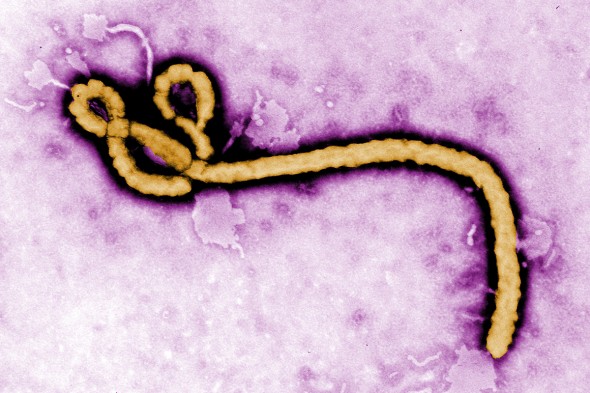Ebola transmission possible through air, researchers say
Is Ebola airborne?
That’s a complicated question to answer, say public health researchers Lisa Brosseau and Rachael Jones.
The Centers for Disease Control and Prevention considers a disease airborne if it could be contracted at a distance from an infected person. According to that definition, Ebola isn’t airborne, Brosseau said, but the CDC should think more broadly and recognize the possibility of aerosol transmission.
Aerosol transmission could occur when there’s exposure to an infected person who’s coughing, vomiting, bleeding — actions that could spray infected particles into the air.
“With aerosols, there’s some spray that can be inhaled when close to the source,” said Jones, assistant professor of environmental and occupational health sciences. “That’s not recognized by the CDC as a method of disease transmission. We think it’s biologically possible that Ebola is transmitted through aerosols.”
Health care workers at higher risk
People at higher risk for aerosol transmission are those who have close or prolonged contact with an Ebola patient, especially health care workers or caregivers.
The general population, however, has less to worry about.
“We’re not going to see Ebola floating down the street,” Jones said. “People with Ebola aren’t infectious until they start showing symptoms, and then they are pretty sick — it’s not like when you have the cold or flu and still limp through your day. I don’t think people with Ebola virus disease are going to be walking the streets and taking the CTA.”
The likelihood of encountering someone with Ebola in public is small, Brosseau said. If you did, “you would be making every effort to move away from them quickly and call 911,” said Brosseau, professor in environmental and occupational health sciences.
Health care workers, however, must take better precautions to protect themselves from inhaling aerosols from infected patients, the researchers said in a commentary published in September by the Center for Infectious Disease Research and Policy.
For the best protection, they should wear fully protective suits and powered air-purifying respirators, Jones said. Initially, the CDC had recommended surgical masks and face shields because they were concerned only about droplets carrying Ebola virus spraying onto workers’ faces.
“If you’re worried about particles spraying on someone’s face, you need a physical barrier so the particles impact on a face shield or surgical mask, not the face, but those kinds of equipment don’t provide protection against inhalation of particles,” Jones said. “You need respirators to prevent inhalation of particles containing Ebola virus.”
Stopping the spread
The CDC and World Health Organizations should focus their efforts on improving equipment for health care workers in developing parts of the world, especially West Africa, Brosseau said.
“It’s not a time for panic, but time for us to ask our government to be as responsive and supportive as it can be of the West African outbreak,” she said. “If we don’t work hard at stopping it there, it will only spread farther.”
In addition to specialized equipment like respirators, developing countries need basic items to keep health care workers safe, such as gloves and protective suits, Brosseau said.
“Those who are involved in transport and triage must receive the same level of protections as those doing the treatment,” she said. “The World Health Organization and CDC need to think more broadly about who is exposed, how they are exposed and how to protect them from exposure so they can continue to have the workforce that’s needed.”
Although most U.S. hospitals have respirators ready for workers to use, some smaller health care organizations don’t have the proper equipment to protect against aerosol transmission of Ebola, Brosseau said.
“The key to success for those settings is to understand what to look for when they encounter someone with Ebola and protect themselves for that short time of encounter,” she said.
Experts in emergency preparedness
More experts — including emergency-preparedness workers for chemical, biological and nuclear events — should be brought into the conversation on protecting health care workers, Brosseau said.
“All of the decision-making going on with Ebola has not been as wide and broad as needed,” she said. “I think that’s why the recommendations and guidelines have not recognized all of the issues that could be faced and all of the workers who could be exposed.
“Folks who have a lot of work with preparedness for chemical, biological and nuclear events have thought deeply and carefully about how to respond, what to wear, how to disinfect equipment. That kind of expertise could be very useful in preparing for and responding to an outbreak.”

